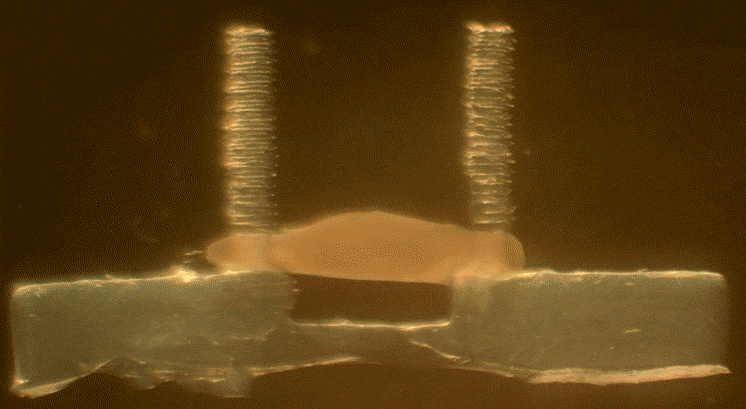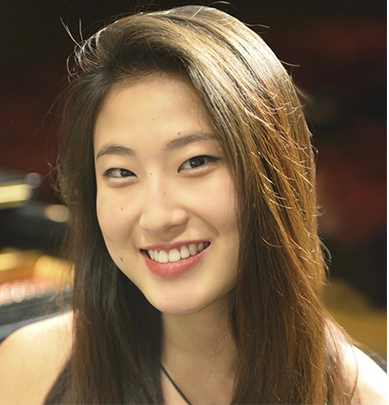Fixing the unfixable with microtissues
For her senior project, CMU alum Sabrina Liu proved that tiny heart tissues can be used to power soft robotic devices.
“If it ain’t broke, don’t fix it”—a familiar expression we use to prevent others from changing the status quo. But what if something actually breaks beyond repair, like a kidney or a liver? How do we fix parts of the body that fail because of disease? Fortunately, scientists, including Materials Science and Engineering (MSE) and Biomedical Engineering (BME) alumna Sabrina Liu, have been searching for ways to repair or replace “broken” tissues or organs with those engineered from an individual’s own cells.
Before graduating from Carnegie Mellon in 2017, Liu contributed to MSE and BME Associate Professor Adam Feinberg’s Regenerative Biomaterials and Therapeutics Group, where she collaborated with graduate students and postdocs to develop technology that could potentially transform human cells into human tissue.
For her senior project, Liu worked with tiny heart tissues to determine if scientists could use them as actuators, or components to power and mobilize, soft robotic devices—devices made from highly pliable materials that mimic the behavior of living organisms.
Liu engineered the microtissues by combining cardiac muscle cells and fibroblasts (support cells) with a collagen solution that gelled when placed in miniature molds and heated to body temperature. After growing these for a few weeks in culture, the microtissues organized into functional muscle tissue that could contract and generate force.

Source: Sabrina Liu
Hinge unit structure combined construct showing spontaneous contraction on day 14 after casting immediately removed from PDMS mold.
Ultimately, Liu proved that engineered microtissues could indeed perform like actuators capable of mobilizing and powering 3-D structures for potential biomedical and soft robotics research applications, including pumps, grippers, and motile devices that can walk. These microtissues in general could also serve as patient-specific models for testing new drugs, as well as building blocks for regenerative therapies for larger scale tissue replacement.
“It was really a proof-of-concept project—proving that these microtissues that other members of the group were researching and developing could eventually be used as actuators that could power soft robots,” says Liu. “We demonstrated that on a simple scale using a 3-D hinge unit structure [two posts connected by a hinge] and a walking bot.”
Liu tried two different approaches when transferring the microtissues onto each 3-D structure: manual transfer and combined casting. For manual transfer, she used tweezers to remove the microtissues from their molds before attaching them to each structure. For combined casting, she first inverted each 3-D structure before inserting them into the wells of the original, miniature molds. Then she used a pipette to cast the microtissues around the entire structure. According to Liu, there are advantages and disadvantages to each transfer method.
It was really a proof-of-concept project—proving that these microtissues could eventually be used...to power soft robots.
Sabrina Liu, Alumna, Biomedical Engineering & Materials Science and Engineering, Carnegie Mellon University
Once the 3-D structures were taken out of the molds, Liu observed the movements of each heart tissue at various time points, both spontaneously and under electrical stimulation. She discovered that her combined casting technique produced robust microtissue actuators capable of mobilizing structures through spontaneous contractions.
Liu captured the movements of each microtissue using a digital video microscope to showcase their ability to power 3-D constructs including a hinge unit structure and walking bot. In numerous video clips, you can see little white strips (the microtissues) pulling and pushing a pair of grooved posts, like two legs connected by a resistance band, stretching inward and outward to strengthen the muscle.
Liu was encouraged to work on this project after spending the previous summer at Harvard University conducting research in the Wyss Institute for Biologically Inspired Engineering. At Harvard, Liu completed a research program where she helped develop a new biomaterial that could be 3-D printed for perforated eardrum patches. When she returned to Carnegie Mellon in the fall, she was ready to build upon the skills she acquired at the Wyss Institute to complete her senior project.
“Dr. Feinberg came up with an idea that kind of combined the 3-D printing experience I had at the Wyss Institute with the experience I had working with skeletal muscle microtissues on previous projects in the Feinberg lab using similar techniques,” she says. “It was a new project Dr. Feinberg wanted to start, and there was a lot of flexibility for me in how to approach it.”
If given the opportunity, Liu says she would expand upon her senior project by exploring how different kinds of stem cells might affect the ability of the microtissues to generate more force and power more complex 3-D structures.

Source: Sabrina Liu
For her senior project, Sabrina Liu worked with tiny heart tissues to determine if scientists could use them as actuators.
“With manual transfer, you have nicely compacted tissue in the mold, but when you go and transfer it, because you are using tweezers, there’s a huge chance of damaging it, and it loses its structure and functionality” said Liu. “The really big advantage with combined casting is that you still have successful compaction, but it’s directly on the structure. So you can cast them, culture them, and literally take them out of the molds pretty much ready to go.”
But first: Liu will be completing a master’s degree at the Center for Bioengineering Innovation and Design at Johns Hopkins University. The program focuses on medical device development and entrepreneurship, with most students either spinning out their projects into start-up companies or pursuing a career in the medical device industry after graduation. Liu hopes to launch her career by starting in a more technical role once she finishes her master’s program.
“Ideally, I want to do R&D engineering in the medical device industry,” she says. “I’m interested specifically in the cardiothoracic space, but I’m also pretty open in terms of the specific field I end up in. Eventually, I want to move on to project management.”
At Johns Hopkins, Liu is in the process of finding solutions for the most challenging problems in the medical field. Much like her senior project, which focused on engineering muscle powered 3-D devices for biomedical purposes, Liu’s current efforts continue to focus on improving human lives.
“During the summer, we mainly focus on identifying unmet clinical needs that can be addressed by medical device solutions that groups work on translating towards the clinic throughout the year,” says Liu. “I want to use my past research experience to make an actual tangible impact in the medical device industry. I’m excited to see how my research and the products I work on will influence actual patients and people in the future.”
